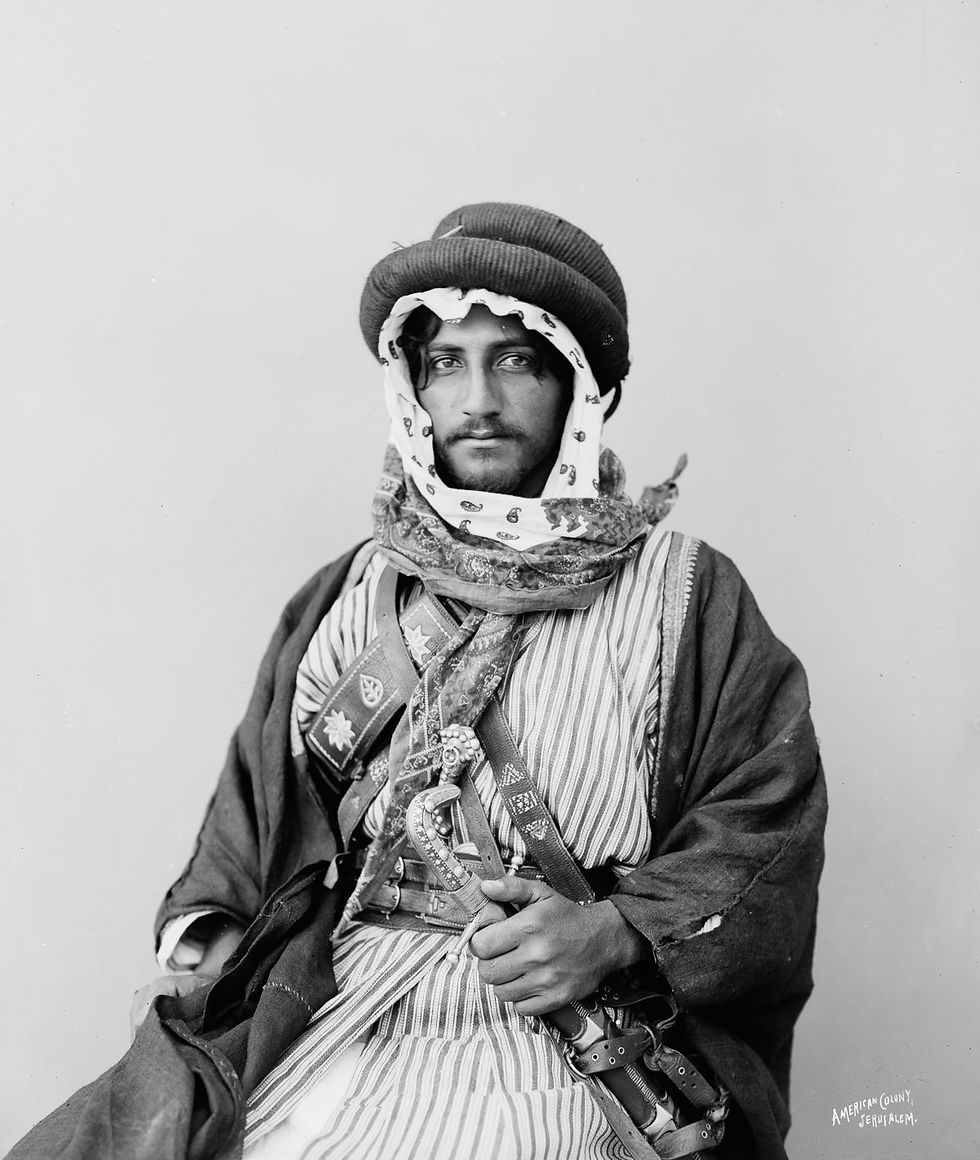The Lens and the Land: The American Colony’s Photographic Encounter with Bedouin Life in Egypt and the Holy Land
- Julian Beckett

- Aug 1
- 5 min read
Updated: Aug 6

In a quiet photographic studio tucked away in Jerusalem at the turn of the 20th century, a group of devout settlers from America and Sweden began capturing images that would shape the world’s understanding of the Middle East. The American Colony Photo Department, later known as the Matson Photo Service, documented everyday life in Egypt, Palestine, and Jerusalem with a care and clarity that stands out even today. But their mission was never just photography—it was redemption, community, and a deeply held belief that living righteously in the Holy Land would prepare them for the Second Coming of Christ.
This is the story of how faith, photography, and Bedouin culture briefly intertwined in the desert light of the Middle East.

The Unusual Mission Behind the Lens
The American Colony in Jerusalem was unlike any other community in the region. Founded in 1881 by a group known as “The Overcomers,” the Colony began when Horatio and Anna Spafford, a devoutly Christian couple from Chicago, left behind personal tragedy in search of spiritual renewal. Horatio, a lawyer and hymn writer (he penned the famous It Is Well With My Soul after losing four daughters in a shipwreck), led the group to Jerusalem with the aim of living communally and charitably in the manner of early Christians.
They were joined in 1894 by 70 Swedish believers from the United States and, two years later, by 55 more directly from Sweden. The movement grew, settling into a former Ottoman palace outside the Old City walls that would eventually become the renowned American Colony Hotel. Though not missionaries, the group took a non-sectarian approach to helping others. They opened schools, ran soup kitchens, and cared for the sick regardless of background—earning them a respected place in the city and a reputation for integrity.
One lesser-known but highly influential project of the Colony was the formation of a photography department.

Elijah Meyers and the Birth of the American Colony Photo Department
In 1898, Elijah Meyers—a Jewish convert to Christianity who had emigrated from India—founded the American Colony Photo Department. Initially intended to support the group financially, the venture soon became one of the most important visual archives of the region. The photographers, including G. Eric Matson (after whom the Matson Photo Service was later named), documented life across Egypt, Jerusalem, and the surrounding areas.

Their work was detailed, respectful, and almost ethnographic in tone. Through their lenses, they recorded Bedouin families, landscapes, architecture, religious rituals, and everyday interactions—long before mass tourism or television had reached the region. Their aim wasn’t just aesthetic; it was devotional and humanistic.
The resulting images offer a unique window into the late Ottoman Middle East. They are serene, often beautifully composed, and show a world at a threshold: ancient traditions holding steady even as modernity crept in.

Bedouin Life in Context
Among the most compelling subjects of the American Colony photographers were the Bedouin tribes they encountered across Egypt, the Sinai Peninsula, and Palestine. The word "Bedouin" derives from the Arabic badawi, meaning “desert dweller,” and refers to traditionally nomadic Arab peoples who herded camels, sheep, and goats across vast arid lands.

Their migrations were seasonal: during the winter rains, they would move into deep desert, and in the dry months they returned to cultivated fringes where water was more accessible. Bedouin society was highly structured, deeply tribal, and patriarchal, often organised under a sheikh supported by a council of male elders. Polygyny, patrilineal inheritance, and tribal loyalty were central elements of their culture.
The American Colony’s images of Bedouin life are respectful and non-intrusive, showing men in flowing robes, women with elaborate jewellery, tents made of goat hair, and daily routines largely unchanged for centuries. These were not exoticised "others"—they were neighbours and fellow humans, portrayed with grace.

A Culture at the Crossroads
The 20th century brought profound shifts to Bedouin life. Governments across the Middle East began nationalising desert lands, limiting traditional movement and access to grazing routes. In Egypt, particularly the Sinai Peninsula, this brought both physical and cultural upheaval. With the rise of tourism in the Red Sea towns such as Sharm el-Sheikh, Bedouins faced pressures to abandon nomadism and enter service economies.
Some did so willingly, adapting to roles as tour guides, cafe owners, and taxi drivers. Others struggled to find employment as the industry brought in outside labourers. Meanwhile, large areas of once-shared land were sold to hotel developers, with the Egyptian government often viewing Bedouin land use as unofficial and impermanent.
In 1999, tensions flared when the military bulldozed several Bedouin-run tourist camps north of Nuweiba. A state agency claimed the tribes had no claim to coastal land, citing a lack of permanent structures before 1982. For many Bedouins, this was the latest in a long line of dispossessions justified by their traditional lifestyle.

Bedouins and the Modern Egyptian State
The Sinai Bedouins' relationship with the Egyptian government remains complex. While the 2011 revolution temporarily relaxed some restrictions, increased tensions followed, particularly after a series of terrorist attacks along the Egypt-Israel border. In response, Egyptian forces cracked down hard—destroying over 120 tunnels used for smuggling goods and people between Egypt and Gaza.
For some tribes, smuggling had become one of the few viable economic activities left.
The destruction of these tunnels sent a clear message: the state was reasserting its authority, and Bedouin cooperation would be expected moving forward. Yet despite these challenges, many Bedouin families continue to advocate for their rights, heritage, and survival in a fast-changing world.
Legacy of the American Colony and the Photo Archive
While the American Colony as a spiritual community dissolved in the 1950s due to internal rifts, its legacy lives on. The American Colony Hotel remains a beloved fixture in Jerusalem, attracting writers, diplomats, and visitors with a taste for the historic and the atmospheric.
The photographs—thousands of them—are now preserved in the Library of Congress and other archives, offering future generations an unmatched glimpse into a region at a historical crossroads. The images of Bedouins, in particular, preserve traditions that have either vanished or been irrevocably altered.
In a way, the mission of the American Colony Photo Department succeeded beyond its founders’ expectations. What began as a humble spiritual experiment produced some of the most valuable visual records of Middle Eastern life ever created.
Sources:
Library of Congress Prints and Photographs Division: https://www.loc.gov/pictures/collection/matpc/
American Colony Hotel History: https://www.americancolony.com/the-hotel/history
“Bedouin” - Encyclopaedia Britannica: https://www.britannica.com/topic/Bedouin
Human Rights Watch reports on land dispossession in Sinai
Egyptian Ministry of Tourism documents (archived)
Written by Julian Beckett, Witness to Ruins
Contributor, UtterlyInteresting.com — exploring the strange and forgotten corners of history.




















































































































































Comments